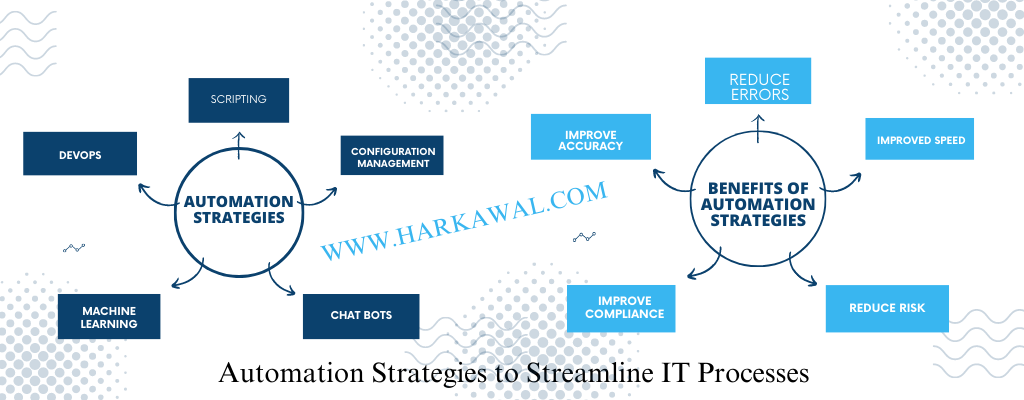Automation Strategies to Streamline IT Processes
In today’s fast-paced digital world, IT departments are under immense pressure to keep up with the increasing demand for efficiency and productivity. One way to achieve this is by automating IT processes. Automation streamlines IT workflows, minimizes errors, and frees up IT staff to focus on more strategic tasks. In this article, we will explore automation strategies to streamline IT processes and enhance efficiency and productivity.

Understanding Automation
Automation is the use of technology to perform tasks with minimal human intervention. In the context of IT processes, automation involves using software tools to automate repetitive, time-consuming tasks. These tasks include software deployment, server provisioning, network configuration, and more. By automating these processes, IT staff free up their time to focus on more strategic tasks, such as improving security, optimizing performance, and enhancing user experience.
The Benefits of Automation
The benefits of automation are many. It help reduce errors and improve the accuracy of IT processes. It can also improve the speed of IT operations, allowing IT staff to respond quickly to issues and minimize downtime. Additionally, automation help standardize IT processes, ensuring that they are consistent and repeatable. This help improve compliance and reduce risk.
Automation Strategies
There are several automation strategies that IT departments can use to streamline workflows. These strategies include:
Scripting: Scripting involves writing code to automate IT processes. Scripting can be used for a variety of tasks, including software deployment, server provisioning, and network configuration. Scripting allows IT staff to automate repetitive tasks, reducing errors and improving efficiency also.
In the context of IT processes, scripting involves writing code to automate tasks such as software deployment, server provisioning, and network configuration.
By automating repetitive tasks, scripting can help IT staff save time and reduce errors. This not only saves time, but ensures consistency in the process and reduces the risk of human error as well.
Configuration Management: Configuration management involves using software tools to manage the configuration of IT systems. Configuration management tools can be used to automate deployment and configuration of servers, applications, and network devices. This help improve the speed and accuracy of IT processes.
DevOps: DevOps is a philosophy that emphasizes collaboration between development and operations teams. DevOps involves automating entire software development lifecycle, from code creation to deployment. By automating software development process, IT teams can reduce errors and improve efficiency.
DevOps is a software development methodology that aims to break down silos between development and operations teams, fostering collaboration and communication between them.
Traditionally, these two teams have worked independently of each other, often resulting in issues such as miscommunication, delays, and errors. DevOps seeks to address these issues by creating a culture of collaboration and communication, where development and operations teams work together throughout entire software development lifecycle.
Automation is a key component of DevOps, with goal of streamlining software development process and reducing risk of errors. By automating tasks such as code testing, building, and deployment, DevOps enables teams to work more efficiently and effectively.
DevOps also emphasizes continuous integration and continuous delivery (CI/CD), which involves frequently integrating code changes and quickly deploying them to production. This approach allows teams to quickly respond to changes and feedback, delivering high-quality software faster and more reliably.
Chatbots: Chatbots are AI-powered tools that can be used to automate IT support. Chatbots can be used to answer frequently asked questions, troubleshoot issues, and even perform routine tasks. This help free up IT staff to focus on more complex issues.
In context of IT support, chatbots can be used to automate tasks such as answering frequently asked questions, providing troubleshooting assistance, and performing routine tasks such as password resets or software updates. By using chatbots, IT teams reduce volume of repetitive and simple queries that require human intervention, freeing up IT staff to focus on more complex issues.
Machine Learning: Machine learning is a subfield of artificial intelligence (AI) that involves development of algorithms that enable computer systems to automatically learn and improve from data. Instead of explicitly programming a computer system to perform a specific task, machine learning algorithms can be trained to identify patterns and relationships in data, and then use this knowledge to make predictions and decisions.
Machine learning can also be used to predict and prevent downtime by analyzing data from various sources, such as application logs and system metrics. By detecting patterns and anomalies in this data, machine learning algorithms could alert IT staff to potential issues before they occur, allowing for proactive measures to be taken to prevent downtime.
In addition, machine learning can be used to detect and mitigate security threats by analyzing network traffic, user behavior, and other data sources to identify patterns of suspicious activity.